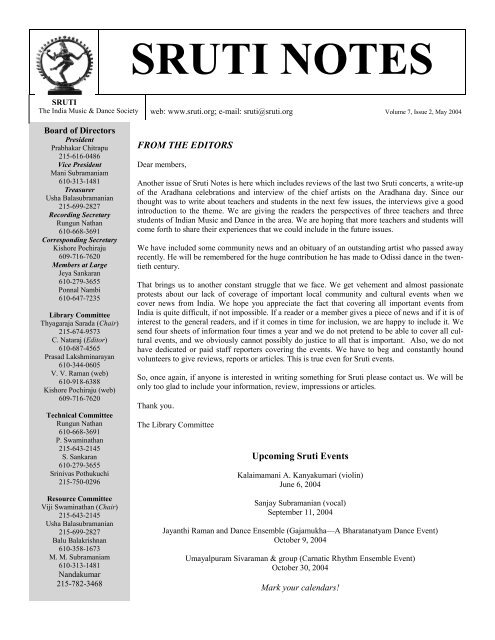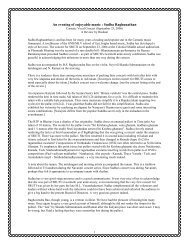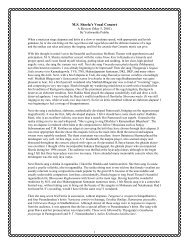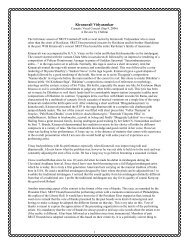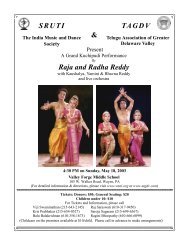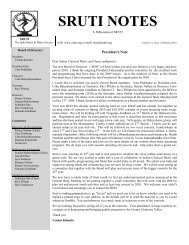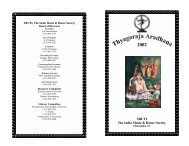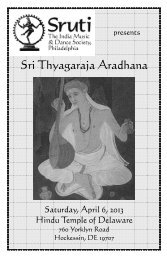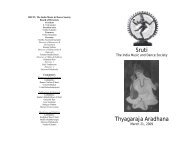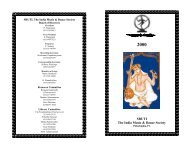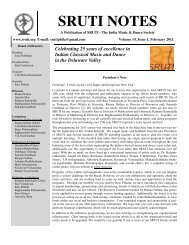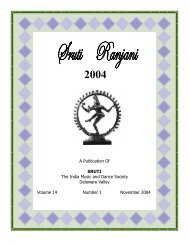pdf - sruti notes
pdf - sruti notes
pdf - sruti notes
Create successful ePaper yourself
Turn your PDF publications into a flip-book with our unique Google optimized e-Paper software.
SRUTI NOTESSRUTIThe India Music & Dance Societyweb: www.<strong>sruti</strong>.org; e-mail: <strong>sruti</strong>@<strong>sruti</strong>.org Volume 7, Issue 2, May 2004Board of DirectorsPresidentPrabhakar Chitrapu215-616-0486Vice PresidentMani Subramaniam610-313-1481TreasurerUsha Balasubramanian215-699-2827Recording SecretaryRungun Nathan610-668-3691Corresponding SecretaryKishore Pochiraju609-716-7620Members at LargeJeya Sankaran610-279-3655Ponnal Nambi610-647-7235Library CommitteeThyagaraja Sarada (Chair)215-674-9573C. Nataraj (Editor)610-687-4565Prasad Lakshminarayan610-344-0605V. V. Raman (web)610-918-6388Kishore Pochiraju (web)609-716-7620Technical CommitteeRungun Nathan610-668-3691P. Swaminathan215-643-2145S. Sankaran610-279-3655Srinivas Pothukuchi215-750-0296Resource CommitteeViji Swaminathan (Chair)215-643-2145Usha Balasubramanian215-699-2827Balu Balakrishnan610-358-1673M. M. Subramaniam610-313-1481Nandakumar215-782-3468FROM THE EDITORSDear members,Another issue of Sruti Notes is here which includes reviews of the last two Sruti concerts, a write-upof the Aradhana celebrations and interview of the chief artists on the Aradhana day. Since ourthought was to write about teachers and students in the next few issues, the interviews give a goodintroduction to the theme. We are giving the readers the perspectives of three teachers and threestudents of Indian Music and Dance in the area. We are hoping that more teachers and students willcome forth to share their experiences that we could include in the future issues.We have included some community news and an obituary of an outstanding artist who passed awayrecently. He will be remembered for the huge contribution he has made to Odissi dance in the twentiethcentury.That brings us to another constant struggle that we face. We get vehement and almost passionateprotests about our lack of coverage of important local community and cultural events when wecover news from India. We hope you appreciate the fact that covering all important events fromIndia is quite difficult, if not impossible. If a reader or a member gives a piece of news and if it is ofinterest to the general readers, and if it comes in time for inclusion, we are happy to include it. Wesend four sheets of information four times a year and we do not pretend to be able to cover all culturalevents, and we obviously cannot possibly do justice to all that is important. Also, we do nothave dedicated or paid staff reporters covering the events. We have to beg and constantly houndvolunteers to give reviews, reports or articles. This is true even for Sruti events.So, once again, if anyone is interested in writing something for Sruti please contact us. We will beonly too glad to include your information, review, impressions or articles.Thank you.The Library CommitteeUpcoming Sruti EventsKalaimamani A. Kanyakumari (violin)June 6, 2004Sanjay Subramanian (vocal)September 11, 2004Jayanthi Raman and Dance Ensemble (Gajamukha—A Bharatanatyam Dance Event)October 9, 2004Umayalpuram Sivaraman & group (Carnatic Rhythm Ensemble Event)October 30, 2004Mark your calendars!
From the President’s DeskBy-Laws CommitteeDear Sruti Friends:I hope you have attended and enjoyed the four events that Sruti offered sincethe last Sruti Notes. These events were the Thyagaraja Aradhana, HindusthaniConcert of Ustad Shujaat Khan & Pandit Debashish Bhattacharya, CarnaticVocal Concert by Vijaya Siva and Flute Workshop & Mini-Concert byDr. N. Ramani. For those of you that attended, a big Thank you! For everyone,a warm invitation to attend the exciting line of upcoming events.The upcoming Sruti events include a Carnatic Violin Concert by Smt. A.Kanyakumari on 6 June (see flyer), followed by a joint event we are planningwith International House on 11 July (details to follow). During the Fall season,we are planning to bring to you a Carnatic Vocal Concert by SanjaySubramanian on 11 September, Bharatanatyam Dance event Gajamukha on 9October and a Carnatic Rhythm Ensemble event by Umayalpuram Sivaraman& group on 30 October. In addition, we are also planning an event torender T.N. Bala’s new musical compositions and a Sruti Day that will providea forum for local talent in both Indian Classical music and dance. Infact, we are even doing some initial work for a major concert by L. Shankarin Spring 2005!I am glad to report that Sruti has received a $25,000 grant from PhiladelphiaMusic Project towards organizing the above mentioned events of L. Shankar,Umayalpuram Sivaraman and Sanjay Subramanian. Sruti also received a$1,200 grant from Pennsylvania Council on the Arts towards general operatingexpenses.In accordance with a resolution passed during the last Sruti General Bodymeeting (December 2003), an ad hoc committee has been formed with SudhakarRao as the Chair. Briefly, the scope of the ad hoc committee is to examinethe Amendments to the Sruti Bylaws proposed during that GeneralBody Meeting and also to extend the examination to the entire Bylaws as awhole. We thank the committee members for volunteering their time for thisimportant task for Sruti.Sruti has also been reaching out to local organizations by facilitating/contributing Indian Classical Music and Dance programs. Firstly, Srutireached out to the International House who were celebrating the cultures ofCommonwealth Nations (including India) on March 19 and we helped arrangea short Bharatanatyam performance by the students of Nardhana Academyof Dance. Sruti also reached out to a local celebration of Smt. Karunamayiby facilitating a short invocatory Bharatanatyam dance performance bythe students of Naatya. We thank Shoba Sharma of Naatya and RamaaRamesh of Nardhana for making these out reach programs possible.I conclude with an invitation to you all to attend the Sruti events, contributeto the Sruti Notes, purchase Sruti products (CDs/Cassettes/Book) and frequentlyvisit our website. Please see the photos of recent Sruti events andalso exchange news & views on the Discussion Forum.With best wishes to all of you,Prabhakar ChitrapuDear Members,The Board of Directors of SRUTI, 2002-2003,proposed amendments to the SRUTI by-laws inNovember / December, 2003. The amendmentswere discussed during the General Body meetingheld in January 2004. A motion was passed duringthat meeting directing the Board of Directorsto form an Ad hoc committee to review all theproposed amendments.The Board of Directors of SRUTI has constitutedan Ad Hoc committee to review its by-laws. Thecommittee consists of Bala Balasubramaniam, H.Y. Rajagopal, T. S. Venkataraman and myself.Prabhakar Chitrapu, President of Sruti will be anex-officio member of this committee. The committeehas been tasked to review the amendmentsthat were proposed in November/December 2003,as well as to review the complete document, andto present their recommendations by September 1,2004. The current by-laws and the proposedamendments are available on our website.SRUTI’s by-laws were originally constituted in1986 and have seen some minor amendments overthe years. The current by-laws have provided agood framework under which SRUTI has growninto its current stature. This review provides us anopportunity to consider the current state of theorganization and recommend any changes to theby-laws to make the organization more effectivein its operations. The amendments proposed lastyear reflect a request from the Board to provide amore effective organizational structure. We hopethat this committee will be able to fulfill thatneed.As part of the review process we would like tohear from you, our members. If you have anycomments or suggestions related to the by-lawsand the proposed amendments please write to us.Your input will go a long way in shaping the futureof this organization. You can forward thecomments to me at 20 Windermere Drive, BlueBell, PA 19422 or email me atsmrao@comcast.net.We look forward to hearing from you.Sincerely,Sudhakar RaoChairman, By-laws Ad hoc committeeThe opinions expressed by the contributors of articles and reviews are published in a spirit of openness of communication andfreedom of expression. They do not necessarily reflect the views of Sruti's Board or its members.2
Classical Music in USA: Teacher PerspectivesJayawant D. BantwalThe age old and universal saying "Teaching is a noble occupation"is well known to everyone. I too am inclined to believe in this saying.However what makes it truly noble is beyond the scope of thisarticle. Suffice it to say, teaching is gratifying as well as challenging.My writing here is focused on teaching music. I gave up myengineering and management career to embrace music, which wasuntil then a part time occupation.Although I never had any ambition to teach Music, my reveredGuruji (Pandit Taranathji) gave me an emphatic Directive to teach,about 26 years ago. However, being more interested in performing,which still is my first preference, I did not attempt to teach. A yearlater I acceded to the requests of two friends (a businessman and asurgeon) and took them under tutelage. Somehow, I was able toteach them a few Taals. But, matching the schedules of these twobusy people was no fun. Finally, a year later or so, this class cameto a grinding halt. I got busy with concert tours with visiting artistsfrom India. Sometime later, a stream of students arrived fromSouth Jersey. They wanted to play Tabla with Bhajans in the newlyconstructed Berlin Temple. Growth of Indian culture, temples, visitingartists and a tremendous desire on the part of parents to teachtheir children Indian culture and music went a long way in increasingthe number of students. As a result some serious studentsstarted arriving. Then came requests from other towns and States,which led to setting up Centers in other areas as far as 100 miles,from Bucks County to Scranton, Pa and from South Jersey to BergenCounty. The only limiting factor has been time.Yes, teaching is indeed a gratifying experience. It is an indescribablejoy to see a seed being transformed into a plant right beforeyour eyes and growing and growing. The environment is providedby the loving parents, who have no reservation whatsoever inspending money and enormous amount of time, week after week,to facilitate the learning process of their beloved children. When Ivisit India for performances, one common question asked by themusic lovers there is how American-born children fare in IndianMusic. My answer is - when it comes to talent and learning, anAmerican-born child is no different from an Indian-born child. Ourchildren here have similar talent, dedication and ability. When itcomes to competitiveness, it may even be stronger here.As regards challenges, there certainly are a few. Tardiness, lastminute changes and absenteeism present frustrating situations attimes. However they are limited to about 5% of the students, in myexperience. Majority of them provide 100% compliance. One ofthe reasons for these negative experiences may have to do withchildren's involvement in too many activities such as Karate, tennis,soccer, basketball, etc., all in the same week. However, theseactivities do not deserve criticism, as they are essential for personalwell-rounded growth as well as admission into well-known Universitieslater. A good time management approach should be of help insorting out the various activities.In conclusion, I should like to acknowledge that teaching has beena very gratifying experience for me. Many children born in thiscountry have done very well with Tabla, keyboard and evenvocal music. However, I cannot lose sight of adults. My oldeststudent is 63 years young and can sing on the stage comfortablyin good harmony with the Tabla accompaniment. There aremany other adults taking Tabla, vocal and keyboard lessons.In many cases what started out as an escape from daily stresshas been transformed into an earnest pursuit of PerformingArts at one's own level. May Indian Music, Dance and Culturecontinue to flourish in this land.Prabha SubramaniamFirstly, I really do not regard myself as a music teacher in thesense that I do not have a steady group of students who learnor have learnt from me, nor do I conduct classes on any regularbasis. That said, a few children have learnt from mewhom I can claim as my students.It all started about ten years ago, when Ms. Meena Pennathurasked me to teach Carnatic music to her daughter Anita. Shewas agreeable to my conditions that I would go slowly.Meena said, she was in no hurry and it was okay with hereven if I took a long time teaching one piece. So, Anita hasbeen learning from me on and off. Apart from her, only AnilChitrapu has learnt from me on any kind of regularity. I havehad some other students like Sowmya Menon who have learnta few pieces from me on a sporadic basis.I have a rather conservative method of teaching. Startingfrom sarali and janta varisais, I proceed to geetham and varnamsbefore teaching kritis. I introduce gamakams when Iteach varnams. Some students would like to perform at theannual Thyagaraja Aradhana, for whom I also teach simplekritis.In my interaction with the parents of my students I find thatthey are always very cooperative and understanding of mymethod of teaching. The children for their part show lots ofinterest and practice sincerely. Their main drawback seems tobe a lack of sufficient exposure to music concerts. Childrenin Chennai get to hear classical music on the radio and TVapart from attending concerts on a more regular basis than inthis country. However, I must admit that that the childrenhere show great enthusiasm in learning despite having manyother diversions. For some children American accent seemsto be a problem. However, once they get past that difficulty,they sound really good.As I said earlier, although I am not a regular teacher of classicalmusic, the few forays I have made in that direction havebeen real fun and also very rewarding.3
Classical Music in USA: Teacher PerspectivesDinakar SubramanianI learnt music as a boy for about 7 or 8 years till my voicecracked and I had to wait a few years before I started learningagain when I was an undergraduate. I was learning Carnaticmusic for most of my undergraduate after which I came to PennState for my graduate study when another fellow graduate student(many Sruti members would remember Jagadisan Shivakumarwho lived in the Philadelphia area in the early 1980’s) and Istarted a music group that used to meet every Friday evening. Icontinue to be a student of Carnatic music.I have been teaching vocal Carnatic music for approximately 3years to children ranging from 6 to 12. I am teaching piecesstarting from the basics (Dhattu, Upper Sthayi) to simple Kirthanamsand Bhajans. I started teaching after a chance phone callthat one of our friends made asking if there were any vocal musicteachers in the area. Coming from a friend, I thought, “Whynot give it a shot myself?” Since then I have been teaching music.I start with the traditional sequence and style with the Sarali varasaiin Mayamalavagowlai, though I find that it is a bit difficultfor the beginner student to sing in Mayamalavagowlai than, say,an Audava ragam such as Mohanam. There is a popular opinionthat Mayavalagowlai is not an easy ragam to learn and to teachwhich I can attest to from personal teaching experience. Theattainment of the swarasthana (position of the note), for Ri, Dhaand Ni is problematic for many children. The closeness of theabove <strong>notes</strong> to either their preceding or succeeding <strong>notes</strong> in thenote progression is the cause of the problem.For this reason, I would prefer to have taught beginner music inan (apparently) easier ragam such as any from the list of audava(5 note) ragams – Mohanam, Shuddha Saveri or GambheeraNattai. Many of you may have listened to Smt. Seetha Rajan’sBodhana CD where she introduces a novel approach of teachingCarnatic music. I have experimented with Mohanam a little bitand I have found that the child finds it easier to grasp these 5-note ragams than Mayamalavagowlai.Theory is explained by explaining the different types of Ri’s,Ga’s, Ma’s, Dha’s and Ni’s in different ragams. At a minimum,we compare ragams, for example, the difference between the Riin Mayamalavagowlai and the Ri in Sankarabaranam, etc. Whena new song is introduced through their Aarohanam and Avarohanam,we discuss how different or similar each note is from theother ragams they have learnt. The Melakartha scheme is alsointroduced much after the beginner stage on a simple level, toshow how ragams are formed – for example, what you get if youchange the Ma (dhyamam) in Shankarabaranam to the Prati Ma(dhyamam). The patterns in the different chakras are also introduced.The electronic keyboard is used in our classes to demonstrate agiven ragam or a passage of swarams that is causing a bit oftrouble in comprehension. In fact, some children respondfavorably to the keyboard by repeating a note correctly afterlistening to the keyboard. The keyboard can also help get thestudent’s <strong>sruti</strong> re-aligned during the course of a given song.The keyboard is thus an invaluable instrument in my teachingmethod. I also have aural quizzes by asking the students whata given note or a sequence of <strong>notes</strong> is by playing them on thekeyboard.Some children have innate talent and some can cultivate thetalent, some swara passages come instinctively to some anddemand effort from some others, but there is no substitute forcontinuous practice. But with children in this country indulgingin multiple activities, practicing Carnatic music is one ofmany things they need to keep up with, and it is a challenge.Many of us including myself will note that in India, we usedto have music class several times a week, but music class wasalso the only extra-curricular activity that we indulged in.Also, in India, music tuition was much more accessible thatyou could walk/bike to class which is not the case here. Parentshave to juggle their busy schedules to bring their childrento class.The biggest aspect of the Carnatic music tuition in my personalopinion is the ability of the student to maintain Sruti. Ifind that this is the one aspect that all students need to concentrateon a continuous basis. The first step in maintaining Srutiis to identify that one is singing off-Sruti. This identificationcan be a tricky task by itself and is one of the most difficultaspects of the learning experience. There are other difficultaspects, such as keeping the Talam (tempo) correctly, properenunciation especially while singing in the second speed, abilityto maintain <strong>sruti</strong> while going below that madhya sthayi orabove the tara sthayi, etc.In addition to regular practice, there is no substitute for listeningto great music when there is a chance. This is easily attainablesince most of children who learn Carnatic music havea household milieu that possesses and promotes our gloriousCarnatic music.I try to provide students with an introduction to Carnatic music,so that they can not only sing songs but also be able todifferentiate ragams, correlate songs of the same ragam, and afew other steps that will help them enrich their own appreciationof this wonderful art form.Rukmini Devi Arundale Anniversary CelebrationsThe 100th birth anniversary of Smt. Rukmini Devi Arundalewas recently celebrated by Naatya with a whole-day event includingpanel discussions, workshops, slide presentations, anda dance performance by Naatya as well as a special Kathakaliperformance by Kunhiramans. It was a fitting tribute to awoman who made so many contributions to continuing thetradition of the arts in India, particularly music and dance.4
Classical Music in USA: Student PerspectivesPlease note that these perspectives of children are presented unedited in order to preserve the candor which seems tocome naturally to young people.Rochitha NathanI got interested in Carnatic music by listening to SudhaRaghunathan and in Bharathanatyam by seeing it on stage.This is my first year taking music classes from Bala Mama(Sri. T.N. Bala). Before that, I learnt a few songs by listeningto Sudha Raghunathan’s CDs. I am also completing my secondyear learning dance from Shilpa Akka (Shilpa Narayan,student of Shoba Sharma).Nobody forced me to learn music. I got the idea by listening toSudha Raghunathan. I would like to keep learning music for along, long time. Also, nobody forced me to learn dance. Iwanted to learn dance from when I was 3 years old. I wouldlike to continue for a long time till I can dance like ShobaAkka and Shilpa Akka.I enjoy music a lot. I love listening to Carnatic music, Hindimovie songs and to jazz. I also love watching Bharathanatyam,some Hindi movie dances, all types of Indian dances andballet. And, YES! I LOVE being on stage. I like to see myfriends sing during the different Aradhanas. I enjoy coming toCarnatic Music and Hindi song concerts. I really like Indianmusic better. Whenever my mom puts western music sometimes,I tell her to turn it off and I put on Indian music.I go every Thursday to Bala mama’s house for music class andI go every Sunday to dance class. Wednesdays is my normalpractice time but I boom out singing at other times too. Sometimes,in music class, my Dad asks my music teacher to teachme a specific piece. Usually, I learn whatever my teachersteach.I speak two Indian languages (Tamil & Kannada). That makesit very easy for me to pronounce all Indian words correctlyvery easily.Rochitha Nathan is a seven year old second grader at CynwydElementary School in Bala Cynwyd, PA. Her extra-curricularactivities include learning Carnatic music, Bharathanatyam,and gymnastics.Chiraag M. NatarajI have had exposure to a wide variety of music due to the interestof my parents and their involvement at various Indiancultural events. We listen to a lot of music at home and theyhave been taking me to a lot of concerts since I was veryyoung. I always enjoyed it very much and that is what interestedme in learning. I have been learning to play the Tablafor about three years. I spend about seven hours on this everyweek, including my lessons. I have been singing for a longtime, may be since I was three years old. I have also beenlearning to play the piano for about two years. I spend aboutthree to four hours every week on vocal music and the piano.Learning the Tabla and Karnataka Sangeetha make me feelunique and special because very few people I know can dothese. I plan to continue learning and practising all of theseas long as possible. I believe that it is better for my teachersto decide what they think is appropriate to teach me at thisstage of my learning. I don’t know what to ask Mr. Bantwalto teach me, but I love what he teaches and enjoy his classesvery much. I sometimes ask my mom to teach me a certainsong and she does, if she thinks it is not too hard for me.I love the sound of the Tabla. My favorite part is when I getto play the very fast “Bols” (long phrases of rhythmic patterns).I love singing the swaras in “Eradanae kaala” (secondspeed) in the ‘Varnas’. I enjoy it very much when I get toparticipate in events like Purandara Jayanthi and ThyagarajaAradhana. On the piano, I like playing the calmer, slowersongs. I have a lot of fun playing my favorite Hindi songstoo. What I like in Indian music is all the “gliding” betweenthe <strong>notes</strong>. I think that it makes Indian music sound very melodious.With the piano, I like the concept of chords. I thinkthey can be very effectively used to control the mood of thesong being played. I love performing on stage. It makes mevery happy. I have been enjoying it since I was four yearsold. I was never afraid of going on stage. I also love to seemy friends performing on stage because it feels good to seeothers learning and being interested in some of the samethings that I am.I am very comfortable in an Indian atmosphere. I feel like Ifit in right away. I know this from experience; from my visitsto India and also at Indian gatherings and concerts. I lovedifferent languages. I like learning the Hindi terms used inmy Tabla lessons. While singing, I care a lot about howwords must be pronounced. I think it is very important. I amvery comfortable with the pronunciation of words in all theHindi songs as well as the Kannada, Telugu and Sumskruthaclassical compositions that I sing. This is due to the fact thatI am fluent in Kannada (Thanks to Pappa and Amma!).My teachers are great; I don’t have any suggestions forthem. My suggestions to other students would be:1. Keep practising till you get it.2. For people learning vocal music, please pay a lot of attentionto the pronunciation of the words in different languages.Chiraag is eleven years old, studying in fifth grade at ValleyForge Middle School. He learns to play Tabla from Mr. J.D. Bantwal. He is also getting vocal lessons in KarnatakaSangeetha from his mom and learning western classical musicon the piano. He loves to read, draw and build robotswith different construction kits.5
Classical Music in USA: Student Perspectives(continued)Neha Mahalakshmi NatarajI listen to a lot of different kinds of music at home all the time.My parents have been taking me to many concerts and dancerecitals since I was about three years old. I have always enjoyedthem very much and think they are beautiful. That is why I wantto learn. I have been learning Bharatanaatya since I was sixyears old. I must have been learning to sing for a very longtime; my first music lesson (pappa has recorded it!) was when Iwas about a year and a half old! Every week, I spend about fivehours practising dance and about three to four hours on music. Ihave also had some training to play the piano but I have nowdecided to learn to play the violin, instead. I play violin at myschool orchestra and I like it very much. I am going to continueto learn and practise as long as I can. I feel very proud that I amlearning something that is Indian and something that is so differentfrom what I usually see or listen. My teachers are very nice.I think they know what is appropriate to teach me. I do tell mymom when I want to learn a specific song; she will let me tryand if she thinks it is not too hard for me, she teaches me thewhole song; if not, she tells me she will teach me when I’m alittle older.I love Bharatanaatya because the dancers look so beautiful intheir colorful costumes and sparkling jewelry. I love Indian musicbecause it sounds so beautiful and melodious. I really enjoysinging the hard Thyagaraja krithis and the cute “Krishna songs”by Purandaradaasa. I also love to sing a lot of old Hindi songsby Lata Mangeshkar. I think she has the most beautiful voice. Ilove performing on stage. It makes me proud of my efforts. Ihave never been shy or afraid of going on stage. I have beenenjoying singing at Thyagaraja Aradhana and Purandara Jayanthisince I was three years old. I also enjoyed the Krishna danceI performed with Rochitha in the middle of our “Tenaali Raama”play that we performed with many children at the TriveniYugaadi celebrations. I feel proud of my friends when I seethem performing on stage too.I feel very comfortable in an Indian atmosphere. I love it when Ivisit India. I feel like an Indian. Whenever I am in India or inan event like Thyagaraja Aradhana, Purandara Jayanthi or Indianconcerts, surrounded by a lot of Indians, I just feel like I belongthere. Also, I find it very easy to deal with the pronunciations inall the Kannada, Samskrutha, Telugu and Hindi songs that Ilearn because I am very comfortable speaking in Kannada; Ispeak in Kannada to everyone in my family. I think that helpsme very much.Neha is nine years old, studying in third grade at New EagleElementary school. She is a student of “Naatya Academy ofIndian Classical Dance,” learning Bharatanaatya. She is alsolearning vocal Karnataka Sangeetha from her mother. She lovesreading, drawing, arts and crafts, science experiments and writingstories and poems.Thyagaraja Aradhana: An ImpressionMeena PennathurAs I walked in to attend the Thyagaraja Aradhana day of Sruti,Sadimchane in Arabi was pervading the auditorium. I made aquick stop at the front desk manned (I guess I should saywomaned) by the treasurer of Sruti, bought the season ticket for2004 and walked in. Looking around for a comfortable seat, Isettled on a seat in the 3 rd row where I had a perfect view of theperformers who were singing with reverence. The stage was fullwith vocalists and instrumentalists. An aura of obeisance andveneration filled the saba. I had missed the Utsava Samprdhayakeerthanas by the children and the first two of the Pancharathnakrithis. I was told that this event was commenced with VunchaVridhi, where the musicians walked on to the stage in a processionsinging the Utsava Sampradaya keerthanas. Oh well, 8:30a.m on a Saturday morning was a tough sell for me and I knewit was going to be a long day. Devotion filled my heart as I receivedthe Prasadam that was distributed after the Pancharantnam.The individual participation segment was now in progress. Thechildren one after another sang with a lot of enthusiasm - somewith twinkle in their eyes, some obviously shy to be on stage,some stealing a glance at their teacher and parents for appreciationand approval, some wanting to impress and some blissfullyindifferent to everything around them. The thought did cross mymind - do these children really know what this day was about?Should the participating children be asked to write a sentence ortwo on Thyagaraja or the meaning of the song, as a prerequisite?This would achieve many things, children would understandthe significance of the celebration, the teachers would beforced to teach also the meaning of the song and the greatnessof the composer, SRUTI, in the process, may end up with somematerial for the newsletter written by the children.On a different note - I failed to see the connection between solomridangam and tabla rendering at Thyagaraja Aradhana. I believeit undermines the significance of paying homage to a greatcomposer and ends up being talent show. This is my personalopinion - though I heard, a few in the audience share my view.While children should be encouraged to perform and parentsgiven an opportunity to see their children perform, it should beat a different event and not under the banner of aradhana day.The adult participation followed. I was amazed at how manygood musicians we have amongst us not to mention the ocean ofsongs written by one composer. In an attempt to best use theavailable time, SRUTI was preparing for the next artist as onewas singing - with two sets of microphones on stage. As a result,the center of the stage was not used, this appearing morelike an assembly line set up. I have seen this technique adoptedby many organizations but leaves something lacking in spirit.The day came to a conclusion with the concert of ProfessorSubbulekshmi. She was accompanied by Kalyani Ramani andwas supported on the violin by Radhika Mani and on mridangamby Suresh Ramachandran. This day was well spent, Ithought to myself, as I was leaving the auditorium. I extend mycongratulations to the new SRUTI committee for organizing anenjoyable day.6
A Chat with theThyagaraja Aradhana Concert ArtistsLatha NatarajIt was a beautiful afternoon. At Sruti, we were celebrating ourannual Thyagaraja Aradhana in honor of one of the greatestcomposers in Karnataka Sangeetha. After participating in thetraditional “Utsava” of Sri Thyagaraja and listening to the beautifulrenderings of Utsava Sampradaya Krithis by our juniors andPancharatna Krithis by our own Sruti artists, we were close tothe end of individual presentations by almost a hundred, veryenthusiastic participants. The artists arrived; they were to beperforming in the evening concert, which was the highlight ofthe day’s events. Professor Subbulekshmi and her daughter Smt.Kalyani Raman along with her two, very energetic sons and theirpatient father, the violinist, Smt. Radhika Mani and mridangist,Sri Suresh Ramachandran were all in very good spirits and adelight to talk to.The artists were individually requested to talk a little aboutthemselves, their prime motivation factors for learning music,their formal training, their careers as performers, and their adviceto students of music.Professor Subbulekshmi:My father’s encouragement was the prime motivating factor forme to learn music. He was very enthusiastic about music. Hewas a music critic, an astrologer and a Sanskrit scholar. Mybrother, Veena Venkataraman is a very well known Veenaplayer. He is a part of the Veena-Venu-Violin trio with Sri. LalgudiG. Jayaraman and Dr. N. Ramani.I started my formal training when I was ten years old. I learnedat the Music Academy in Thiruvananthapuram, Kerala. I wenton to work at the Swati Tirunal College of Music (earlier knownas the Music Academy) and retired in 1992 as the Head of theDepartment of Veena after thirty-two years of service. I haveperformed on National Television and National Radio. My firstconcert was at the age of fifteen. I have been performing since1951 in several places in South India as well as in Bombay. Ihave performed live on Malaysian Radio in 1997; it was a onehourvocal concert immediately followed by a one-hour Veenaconcert. I enjoyed that very much.My advice to youngsters learning music: Learn the concepts ofRaga, Bhaava, TaaLa and Gamakas well. Face to face learningfrom a good Guru is very important to achieve this. Get goodtraining and make sure you keep up regular practice.Smt. Kalyani Ramani:My prime motivation factor for learning music was my mother.I always watched and listened when my mother was teaching. Idecided on a career in music at a very young age. I started myformal training at the age of seven. I am a gold medalist andhave a Master’s degree in Music from Kerala University. I latercontinued my training with Smt. Neela Ramgopal after 1992. Ihave performed as a ‘B’ grade artist at All-India-Radio Bangaloreand Thiruvananthapuram and also on the ThiruvananthapuramDoordarshan.My advice to students of music: Start young. Learn to focus.Responsibility, respect and discipline are very important.It is very important to learn about our culture andheritage. Practice is extremely important; it should neverbe time-bound, just practise till it is perfect. Another thingI would like to emphasize is ‘Listen and learn’; listen to alot of music, go to concerts.Smt. Radhika Mani:My parents were the prime motivating factor for me tolearn music. My mother is a well-trained vocalist and extremelyenthusiastic about music. I have had the honor ofperforming at several concerts in India, USA and Australiaand at several prestigious institutions. I have also enjoyedperforming with many well known musicians.My advice to students: Listen to lots of music. Keep upregular practice; it is very important.Sri. Suresh Ramachandran:I am actually a mathematician. My parents’ enthusiasm formusic motivated me to learn the Mridangam. Both myparents are musicians. I grew up with my two sisters whoare also vocal artists. I trained under the tutelege of Sri.T.V.Gurumurthy at the Palani School of Mridangam. I feelhonored, having played with several well known artists. Iam also a graded artist of All-India-Radio. I have enjoyedperforming in AIR, Doordarshan and several sabhas.My advice to students learning music: Listen to a lot ofmusic. Listen to other students as well as professional artists.It is very motivating.Concert Review: Prof. Subbalekshmi & Smt.Kalyani RamaniRajee RamanBeing a native of Thiruvananthapuram, I was naturallyexcited at the prospect of listening to Smt. R. Subbalekshmi,along with her daughter Smt. Kalyani Ramani, on theThyagaraja Aradhana day. Having regularly listened to herVeena recitals on All India Radio, I was eager to attend hervocal concert.On the Aradhana day, following enthusiastic performancesfrom promising youngsters in vibrant costumes, the stagewas set for the concert to begin. A concert on a ThyagarajaAradhana is unique in a couple of respects; for one, usuallyall the items rendered are the Saint's compositions; it's areverential tribute, as the word Aradhana de<strong>notes</strong>. Smt.Subbalekshmi's concert was just that- a tribute that broughtout both the beauty and Bhakthi Bhava inherent in Thyagarajakrithis.7
What better way to flag off a concert than with a soothing Mayamalavagoula,the krithi being Meru Samana? A nice Neraval sequencefollowed by Kalpanaswaras rounded off this piece. A briefsketch of Begada preceded Samiki Sari. Maragathimanivarna inVarali was well rendered after a short alapana by Smt.Kalyani.Kalyani Ramani, who is a well-known music teacher in New Jersey,is proof for the fact that the fruit does not fall far from thetree. Her succinct Arabhi alapana, peppered with sancharas thatbrought out the essence of the raga, was well received. RadhikaMani's response on the violin was equally good. O Rajeevaksha, aThyagaraja gem was rendered in all its splendor.Smt. Subbalekshmi, who was the Principal of Sri Swati ThirunalCollege of Music, has had the good fortune of learning from bothSemmangudi Srinivasa Iyer and K.S.Narayanaswamy. In myhumble opinion, this was apparent in the high quality of the sangathisrendered and the raga bhava in the alapanas. Smt. Subbalekshmishould also be commended for the choice of raga andtala mix.The Saranaga krithi, Mamava Raghurama, enlivened the concertwith its tempo. The main piece for the day, the Thodi masterpiece,Emi Chesite Nemi, in Mishra Chappu was given all theattention it deserved. Thodi is a raga that is almost inexhaustiblein its charm. Smt.Subbalekshmi's voice was in some discomfort,but that did not dampen the raga lakshana to shine through. AThani Avartanam by Sri.Suresh Ramachandran capped the Neravaland Kalpanaswaras. I am no expert in layam, but I thoroughlyenjoyed the Thani. The fast paced Kiranavali piece, Etiyojanalu,provided the right setting for the rare krithi in Neelambari, Neekedayarada. I must mention here about the SrutiRanjini bookletbrought out for the occasion. The lyrics and meaning of four orfive songs from the concert were provided in there. I found thisneat - for once, the audience could relate to the lyrical beauty ofthe composition.A Managalam in Surutti, Maakulabrochuta, was the penultimatepiece followed by a viruttam praising the singular devotion ofThyagaraja towards Rama, in Madhyamavathi. Thus the curtaincame down on a concert, even though plagued by microphonetroubles, was marked by the dedication and sincerity of the artistsin showcasing one of the greatest composer's legacy. Indeed, avery satisfying concert.Kritis rendered at the concert are listed below for your reference.Merusamana – Mayamalavagoula- Adi; Samiki Sari- Begada-Rupakam; Maragathamanivarna- Varali- Adi; O Rajeevaksha-Arabhi – Mishra Chappu; Mamavaraghurama- Saranga – Rupakam;Emi Chesite Nemi- Thodi – Mishra Chappu ; Etiyajanalu –Kiranavali- Adi; Neeke dayarada- Neelambari – Mishra Chappu;Maakula brochuta- Surutti – Mishra Chappu; Thyagaraja- Madhyamavathi.Rajee is an ardent student and rasika of Carnatic Music. She liveswith her family in the Exton area and works as a Software Engineerfor Unisys.Concert ReviewShujaat Hussain Khan with Shubhankar BanerjeeDebashish Bhattacharya with Shubashish BhattacharyaAllyn MinerA performance in Philadelphia on April 9, 2004 by ShujaatHussain Khan was a fitting way to celebrate the life andmark the passing of India’s legendary sitarist Ustad VilayatKhan, whose death in Mumbai in March was a major eventfor the world of Hindustani music. The contributions ofUstad Vilayat Khan to sitar style and to the aesthetics ofNorth Indian instrumental music are deep and pervasive.The innovative techniques that brought the lyrical soundsof vocal music to the instrument, and the power and speedthat thrilled the audiences were his gifts to twentieth centurymusic. Thus it was with particular excitement thatPhiladelphia welcomed his eldest son, Shujaat, who hadnot performed in the Philadelphia area in the recent past.The Prince auditorium was full to capacity with a mix ofseasoned Indian music listeners and the curious from theuniversity community. After a brief welcome and introduction,the performers walked on stage followed by severaldisciples who sat to the sides as the musicians settled themselveson the low dais. The sitar looked small in the handsof Shujaat. At the age of 44, he cuts an impressive figure,and is well established as one of the most powerful andinventive sitar players of his generation. He spoke a fewwords to the audience, announcing that he would play ragaVachaspati, and that he would deviate from the norm of asitar performance to follow a vocal format, playing most ofthe alap in the context of the bandish, the composition, setto tintal.The powerful right hand strokes with their chord-likesound, and the intricate left-hand pulling were marks of hisfather’s style, but the whimsical progression in his explorationof the raga was entirely his own. He would play aphrase, then pull out of it an unpredictable series of skillfulreiterations, drawing the audience in with his fancifulideas. He would burst into sudden fast-speed runs that surprisedand pleased the audience, perhaps puzzling thosewho were used to the chaste conventions of a traditionalalap. With his unconventional style, Shujaat made the musicand the instrument his own. He often chose to bring outa sweet, folk-like melody in this rag, centering on thephrase Komal Ni Sa Re Ga, and only occasionally emphasizingthe relative dissonance of the tivra Ma. The percussiveforce of his strokes were pleasing to many in the audienceand startling to some. In his rhythmic work, Shujaatchose to surprise and delight the audience by returning tothe mukhra of the gat, the leading phrase, in unpredictableand difficult ways. In his medium-speed gat in tintal, themukhra came at a particularly subtle place in the tal cycle.Shubhankar Banerjee matched Shujaat’s brilliant techniquewith strong and nearly show-stopping virtuosity on thetabla. His displays of incredible speed and intricate tihaiswere a suitably dazzling counterpart to Shujaat’s playing.8
In the second piece, the melodious raga Tilak Kamod, Shujaat sang in interludesbetween his playing. This is a new aspect of sitar performance done byothers in the family as well, but for which Shujaat has become particularly wellknown. His CD, Lajo Lajo was a hit, and indeed, a request for this song washeard from the audience. He has a sweet voice reminiscent of that of a film orpop ghazal singer. The blend of classical and light music which he brings tothis part of a performance is loved by many in the audience, while traditionalistsmay be concerned at the non-classical direction this seems to be taking sitarperformance. In any case, Shujaat Hussain’s concert was a revelation to manywho had never heard him before, and a treat to the entire audience.The second half of the concert was a performance by Debashish Bhattacharya.Brought up in music from childhood, Debashish is another one of the brilliantyounger instrumentalists in Hindustani music today. As he came to the platform,many in the audience who had not heard him must have wondered if anyonecould give a successful performance following on Shujaat Khan. Debashishbegan with a spoken introduction, explaining that though derived fromthe western guitar, the instrument has now become entirely Indian. From thevery first <strong>notes</strong> of his alap in raga Jog it became clear that he would indeed beable to draw the audience into his performance. He began on the low strings ofthe guitar, using a glass egg-shaped slide in his left hand and three metal pickson his right. The deep, rich tones of the instrument were immediately appealing.He changed to a metal cylindrical-shaped slide as he moved to the upperstrings. His alap, though conventional in layout, was strikingly imaginative.Though it moved methodically up the scale, it took surprising loops andsweeps. The variety of sounds and the musical feeling that he pulled out of theinstrument was really amazing. As he moved through the alap, a quality of noveltycontinually held the attention. Like Shujaat, Debashish appears admirablyfree to follow his own imagination without having to imitate an elder’s style.This is the sign of both good musicianship and a healthy music. As he beganthe rhythmic sections of his performance, Debashish’s skill and inventivenessonly seemed to increase. The gat in a mid-tempo jhaptal (ten beats), conveyedat the same time a sense of leisure and razor-sharp precision. The natural qualityhe brought to the fast and difficult rhythms and tihais was really impressive.His brother, Shubashish on tabla, was a fine match, answering Debashish’sexhilarating tans with equally dazzling compositions and multiple tihais. Hisanimated playing style made him a pleasure to watch.As a second piece, Debashish brought out an instrument of his own modification,the slide ukulele. The ukulele, a four-stringed instrument shaped like asmall guitar, had a humble history of providing simple rhythmic background toHawaiian song. Debashish produced beautiful rich sounds from this modestinstrument, and in his very original rendition of raga Bhairavi.,guitar playersand observant listeners in the audience could hear shades of western musicsuch as blues, jazz, and experimental riffs, used with taste and originality. It isno surprise that he is in demand for collaborations and guitar workshops in thewest as well as in India.This fine concert of two Hindustani instrumentalists playing so well so early intheir careers was a reason for listeners to have full confidence in the future ofthis music.Allyn Miner is a concert performer on the North Indian sitar. She is a SeniorLecturer in the Department of South Asia Studies at the University of Pennsylvaniawhere she teaches South Asian music and performing arts. Her research,publications and teaching interests include the history of performance,music in history and medieval and early modern textual studies.Kelucharan MohapatraViji SwaminathanThe world of Indian dance mourns the loss ofKelucharan Mohapatra, a pioneer who enrichedand perfected the art of Odissi during his incrediblecareer spanning more than six decades.The legendary Odissi dancer and guru, passedaway on April 7, 2004 at the age of 78. He issurvived by his wife Laxmipriya, his son Ratikantaand daughter-in-law Sujatha Mohanty.Born into a family of Patachitrakars (painters oftraditional Pata-Chitra) on January 8, 1926 atRaghurajpur on the coastal district of Puri, Kelucharanlived a life of unending dedication tothe arts of dance and music. His love for danceand music took him on an incredible artisticjourney, from humble beginnings as a Gotipua(boy dancer dressed like a girl and dancing likethe maharis or temple dancers) in his childhood,to a globally respected dancer, percussionist,composer, choreographer and teacher.Credited with elevating Odissi to the status of aclassical art form, Kelucharan Mohapatra, inassociation with the Odissi Research Center inBhubaneswar, made invaluable contributions tothe codification and systemization of the Odissistyle.Kelucharan Mohapatra was a highly reveredguru. He trained hundreds of students many ofwhom went on to become highly distinguisheddancers and teachers themselves – Sonal Mansingh,the Late Sanjukta Panigrahi, the LateProtima Bedi, Madhavi Mudgal and KumkumMohanty, to name a few.Mohapatra’s artistic creativity and extraordinarysense of form and technique are evident inthe more than fifty dance ballets he choreographedand produced. He also has to hiscredit, more than two hundred solo compositionsincluding pallavis and ashtapadis fromGita Govinda (though not fortunate enough tosee the great artist in action at Sruti, our audienceshave been treated to some of his compositionsand choreography: “Lalita LavangaLata”, "Dhira Samire" and "Yahi Madhava” inthe two mesmerizing performances by SanjuktaPahigrahi and the more recent presentation ofthe Arabhi pallavi by the Nrityagram danceensemble.)For his invaluable contributions to the Odissidance form, Mohapatra received many honorsand awards – Sangeet Natak Academy Awardreached him in 1966, Padma Shri in 1972, Kalidasaward by the Madhya Pradesh Governmentin 1987, Padma Bhushan in 1989 and PadmaVibhushan in 2000.9
SRUTIThe India Music & Dance Society135 Brochant CirBlue Bell, PA 19422SRUTI MEMBERSHIP FORMMail check and form toSRUTIThe India Music & Dance Society135 Brochant CirBlue Bell, PA 19422Name:Address:Phone Number:__________________________________________________________________________________________________________________________________________________________________________________________ Email: ___________________________Type of membership (check box):Regular $25 Life $100 Patron / Donor $50010


